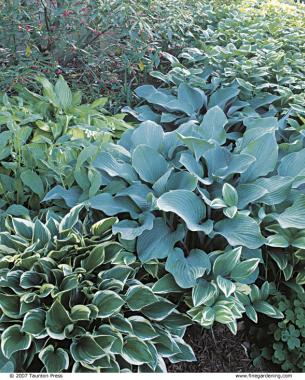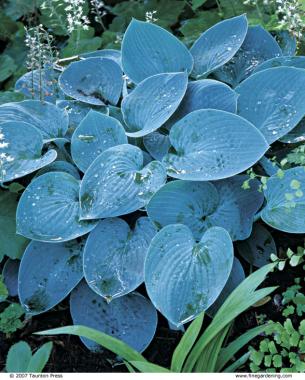
Whether it’s the blue sky or the blue sea on a crystal-clear day, the raw emotion of blues music, the comfort of blue jeans, or the naughtiness of blue movies, people are fascinated by blue. Interestingly enough, the plant kingdom was short-changed when it comes to blue flowers and foliage. And, of course, we always want what we can’t have, or desire what seems to be the most scarce. Perhaps this explains gardeners’ love of blue plants, and in particular, blue hosta.
My fascination with blue hosta is a bit more utilitarian than romantic. In my mind, there is nothing quite like the bluish foliage of hosta. Green- and gold-colored foliage plants are everywhere. Even purple-foliaged plants have become common in nurseries. But short of going to the tropics, plants with blue foliage are hard to find.
There are many choices, even puckered and petite

Blue hostas come in a range of sizes, shapes, and habits, but it’s the larger selections that are best known. Most blue-leaved giants are built like sumo wrestlers—wider than they are tall. For those who think bigger is better, Hosta sieboldiana ‘Elegans’ is a garden gem. This plant is considered the grandfather of all blue-leaved hostas, and its thick, rounded, corrugated blue leaves develop into a 4-foot-wide by 2-foot-tall clump. Other selections like ‘Blue Mammoth’ and ‘Blue Angel’ also reach epic proportions, while ‘Blue Umbrellas’ is rated one of the best giant blues for its metallic-blue, glossy foliage.
Gardeners who like hostas with character are usually drawn to the sculpted selections derived from the old standby, H. tokudama, with its corrugated and cupped blue leaves. Its most famous offspring is ‘Love Pat’, which displays its heritage with extremely thick and puckered blue foliage. My favorite of this group is ‘Abiqua Drinking Gourd’. Its cupped leaves remind me of the old gourd dippers I once used to fetch water from the well.

Designers and collectors are also attracted to hostas with unusual growth habits. ‘Krossa Regal’ was the first—and is still the best—of the vaseshaped hostas, thanks to its ancestor, H. nigrescens, the only vase-shaped species. ‘Krossa Regal’ makes a great accent plant with its smooth and cupped blue leaves. ‘Salute’ also has a vaselike habit, but on a much smaller scale, with twisted blue leaves that grow upright instead of lying flat.
‘Elvis Lives’ was the first hosta to combine the arched habit of the Japanese rock hosta (H. kikutii) with blue-colored leaves. H. kikutii was also used to produce ‘Hillbilly Blues’, the first flat-spreading blue-leaved hosta. It measures 3 to 4 feet wide by 10 inches tall and has the deeply impressed, textural leaf veining prevalent in H. kikutii.
Detail-oriented gardeners, or those with small spaces, truly appreciate the appeal of small hostas. ‘Popo’ and ‘Baby Bunting’ are the bluest of the miniatures. These tiny selections sport leaves that are bluish-green on delightfully compact mounds.
The best of the blues
Blue-leaved hostas come in a range of shapes, sizes, and habits. Since space considerations are important when choosing hostas for the garden, here’s a list that classifies blue-leaved cultivars by the spread of the plants when mature.
SMALL
(up to 12 inches wide)
‘Baby Bunting’
‘Blue Danube’
‘Blue Moon’
‘Dorset Blue’
‘Hadspen Hawk’
‘Popo’
MEDIUM
(12 to 24 inches wide)
‘Abiqua Drinking Gourd’
‘Blue Jay’
‘Blue Shadows’
‘Blue Wedgwood’
‘Fragrant Blue’
‘Hadspen Blue’
‘Osprey’
‘Pearl Lake’
‘Salute’
‘Valentine Lace’
LARGE
(24 to 48 inches wide)
‘Azure Snow’
‘Big Daddy’
‘Blue Belle’
‘Blue Heaven’
‘Elvis Lives’
‘Frances Williams’
‘Halcyon’
‘Hillbilly Blues’
‘Krossa Regal’
‘Lakeport Blue’
‘Love Pat’
‘Sea Sapphire’
H. sieboldiana ‘Elegans’
‘Tenryu’
EXTRA LARGE
(wider than 48 inches)
‘Big Mama’
‘Blue Angel’
‘Blue Mammoth’
‘Blue Umbrellas’
Create combinations with color and texture in mind
Since I landscape my gardens in “drifts of one,” I am always on the lookout for a plant that can fit into any setting. Like a good politician, a blue-leaved hosta will take on a different personality depending on what’s planted nearby. Blue hostas can be used in relaxing color combinations with harmonious shades of green, or with colors like yellow and orange to create more shocking combinations. A combination in one of my former gardens that really made visitors scream was a blue-leaved H. sieboldiana ‘Elegans’ planted beneath an orange-flowering azalea. This shocking contrast would make even Howard Stern blush.

I try to avoid what I call the Hulk Hogan approach to landscape design by paying close attention to the scale of the plants I combine. For instance, a large specimen like ‘Blue Angel’ planted next to my very showy but more demure toad lilies (Tricyrtis spp.) would dwarf the lilies and hog the spotlight. Instead, I use companion plants like Acorus gramineus ‘Ogon’ that can hold their own with a large hosta. On the other hand, a smaller hosta, like ‘Blue Heaven’, needs to be paired with a plant more its size. Corydalis lutea not only matches the hosta in scale, but its grayish-green foliage complements the hosta’s blue-green foliage nicely.
To create other peaceful combinations in my garden that I call “Prozac moments,” I combine blue hostas with foliage plants that provide textural contrast. Placing solid-leaved hostas among lacy-leaved ferns like Japanese painted fern (Athyrium niponicum ‘Pictum’), male fern (Dryopteris filix-mas), or maidenhair fern (Adiantum pedatum) gives my eyes a place to rest. And when using taller ferns such as royal fern (Osmunda regalis), cinnamon fern (Osmunda cinnamomea), or log fern (Dryopteris × australis) as a backdrop, the delicate fern fronds soften the hostas’ edges.
Ferns are certainly not the only plants that provide textural contrast to hostas. The list also includes bleeding hearts (Dicentra spp.), Solomon’s seals (Polygonatum spp.), sedges (Carex spp.), toad lilies (Tricyrtis spp.), mondo grasses (Ophiopogon spp.), and lilyturfs (Liriope spp.).
Keep blue hostas in shade to preserve their coloring
If you take your finger and wipe it across a blue hosta leaf, you will notice that the leaf is actually green. The blue color is nothing more than a layer of wax called bloom that wears away over the course of a growing season with exposure to sunlight, heat, or rainwater. In areas with high summer temperatures or lots of rainfall, blue hostas will not stay blue for long. Here in the South, my hostas usually remain blue into mid- or late June. In cooler climates, the blue color can remain through most of the growing season. And since most blue hostas produce only one flush of leaves per year, once their color is gone you will have to wait until next season to see the blue again.
As a general rule, blue hostas require a bit of light shade, both for preservation of the blue color and for prevention of leaf scorch. A moist soil rich in humus is preferred, and exposure to a bit of cool morning sun will grow the best clumps. Hostas are very heavy feeders, so don’t be shy when it comes to using plenty of good compost, manure, or other organic fertilizer. I apply an organic blend like Plant Tone every spring. Mushroom compost and high-quality, composted manure also make good top dressings in spring.
Most gardeners are all too familiar with the standard pests that plague hosta: deer, voles, and slugs (ranked in order of size and amount of hair). I have found that sprays and barriers can be marginally effective against deer and voles, and that a healthy, microbially active garden (complete with plenty of toads) is the best defense against slugs. Also, the leaves of blue hostas tend to be thick, which is a definite benefit in the war against slugs, as thick leaves are much more resistant to chewing damage from slugs than are thin leaves.
Blue-Leaved Hosta at a Glance
Hosta spp.
- A distinct group of perennials from a genus noted for its foliage. Hostas are native to the woodlands and meadows of Asia.
- Hostas grow in USDA Hardiness Zones 3–8.
- The blue coloring comes from a waxy coating that washes away when exposed to rain, heat, and sun.
- Blue-leaved hostas like well-drained soil with lots of humus. They color best in shade and respond to frequent feeding with organic fertilizer.
- They multiply easily and spread by rhizomes. Propagate from seed, or by division once buds appear in early spring.
- Deer, voles, and slugs are natural enemies of all hostas. Because they have thick leaves, however, blue hostas are more resistant to slug damage.
For really large hostas, resist the urge to divide
Just like learning to play golf, growing a mature hosta clump requires patience, as it can take from three to five years for a hosta to reach adulthood. When you purchase a hosta, it will most likely be in its puberty stage, with leaves that are smaller and more pointed than those of a mature specimen. In fact, your hostas, if left to grow into a single large clump, will look so spectacular after a number of years that you’ll probably want to put them in your will to pass along to your heirs.
If you do decide to divide, whether it’s because you want to share with friends or redecorate your beds, simply dig up the plant as the buds start to show in early spring, and then quarter the roots with a shovel. Although you can divide them into smaller pieces, I find that these quarter divisions are just the right size to reestablish quickly and make instant clumps.
Breeding better hostas

Most blue hostas originated from two parents, H. sieboldiana and H. tokudama. Each 4- to 6-foot-wide clump of H. sieboldiana has very thick, round, corrugated powder-blue leaves topped by pure white flowers that rise just above the foliage in early spring—a characteristic of all early-blooming blue hostas. H. tokudama is an elegant, but smaller version of H. sieboldiana. Its leaves are more cupped and it grows at a slower pace. It also has an extreme distaste for hot weather.
The late Eric Smith did the most important breeding of blue hostas while he was working at the famed Hadspen House in England. One season, a late-flowering, small, glossy-green hosta, H. tardiflora, was in bloom, and a spring-flowering H. sieboldiana produced a rare stalk of flowers in fall. Smith began making a series of crosses between the two plants, and continued to breed with his newly created offspring, eventually naming a number of intermediate hybrids that shared characteristics of both parents—late-season flowering with both white and lavender flowers and good blue leaves.
Of the plants that Smith named, some of the best are ‘Blue Moon’, ‘Hadspen Blue’, ‘Dorset Blue’, ‘Blue Wedgwood’, ‘Harmony’, ‘Brother Ronald’, ‘Camelot’, and ‘Halcyon’. Of these, ‘Blue Moon’ and ‘Dorset Blue’ are quite small, reaching only 1 foot wide at maturity. Others, such as ‘Halcyon’, can make impressive 3-foot-wide clumps.
As with any commodity, there is always the desire to build a better mousetrap, and hosta breeding is no exception. The vigor, fragrance, and diversity of leaf shapes among blue hostas has never measured up to that of their green cousins. And compared to daylily breeding, there are only a very few true hosta breeders. (Sorry, but folks who simply collect and grow seed don’t count.)
One of the biggest challenges facing hosta breeders is developing a truly fragrant blue hosta that produces new leaves all summer. Many breeders are busy combining the genes from the fragrant-flowered H. plantaginea, which produces new leaves throughout the summer, with blue-leaved hostas. If breeders could produce a more fragrant range of hostas like ‘Fragrant Blue’ that produced new blue leaves all season, it would truly change the color and smell of our shade gardens.
It’s easy to grow hosta from seed, but as with children, don’t expect them to look or behave exactly as their parents do. Although the offspring will have some traits from each parent, the number of blue offspring from seed will be low. Exceptions to this rule arise when sowing the seed of ‘Dorset Blue’, which tends to yield a higher percentage of blue-leaved offspring than other blue hostas.
Seeds can be gathered as soon as the pods begin to turn yellow—usually September through November, depending on your location. I like to sow my seed indoors under lights. In spring, I pot them up and place them outdoors where they should fill a gallon-sized pot and flower by the end of summer. You can also sow the seed directly in the ground, but expect to wait three or four years to get a comparably sized plant and your first flowers.
Fine Gardening Recommended Products

XLUX Soil Moisture Meter

Rain Bird PATIOKIT Drip Irrigation Patio Watering Kit

RAINPOINT Sprinkler Timer with Brass Swivel

















Comments
Now you can play dvd windows 10 completely free of cost.
Log in or create an account to post a comment.
Sign up Log in